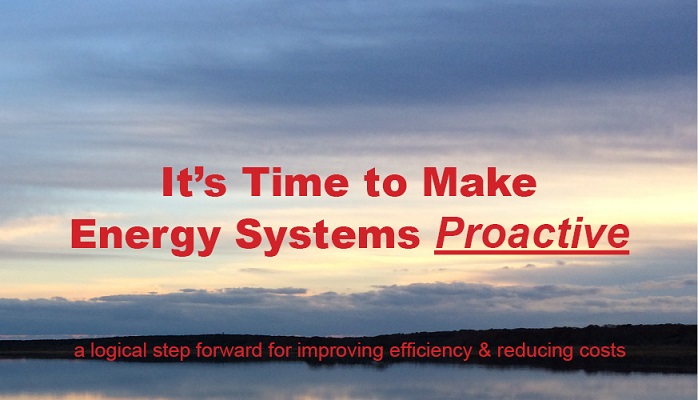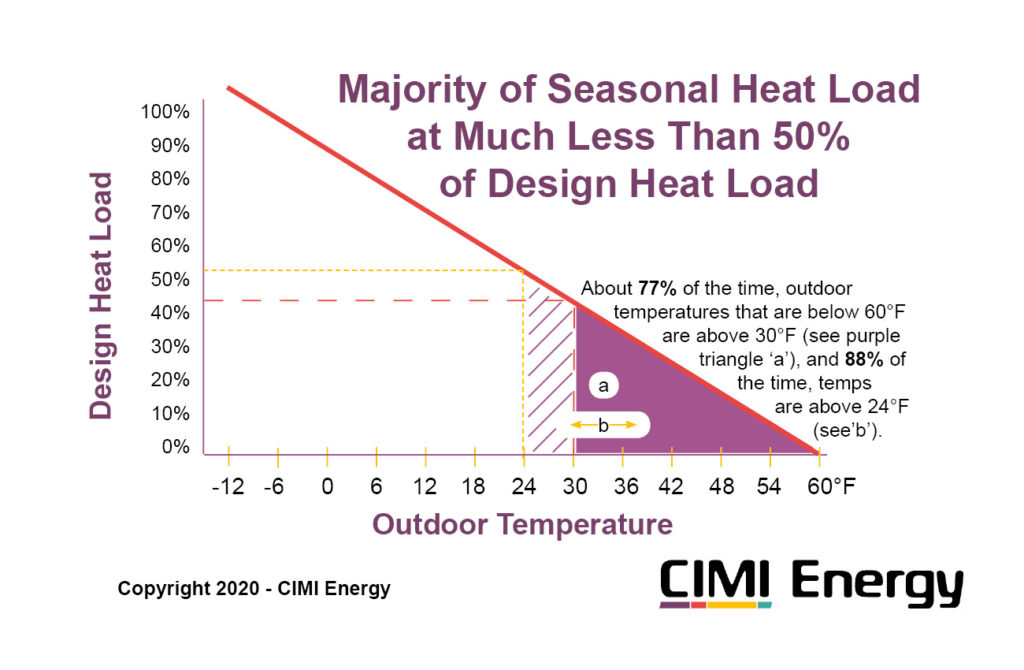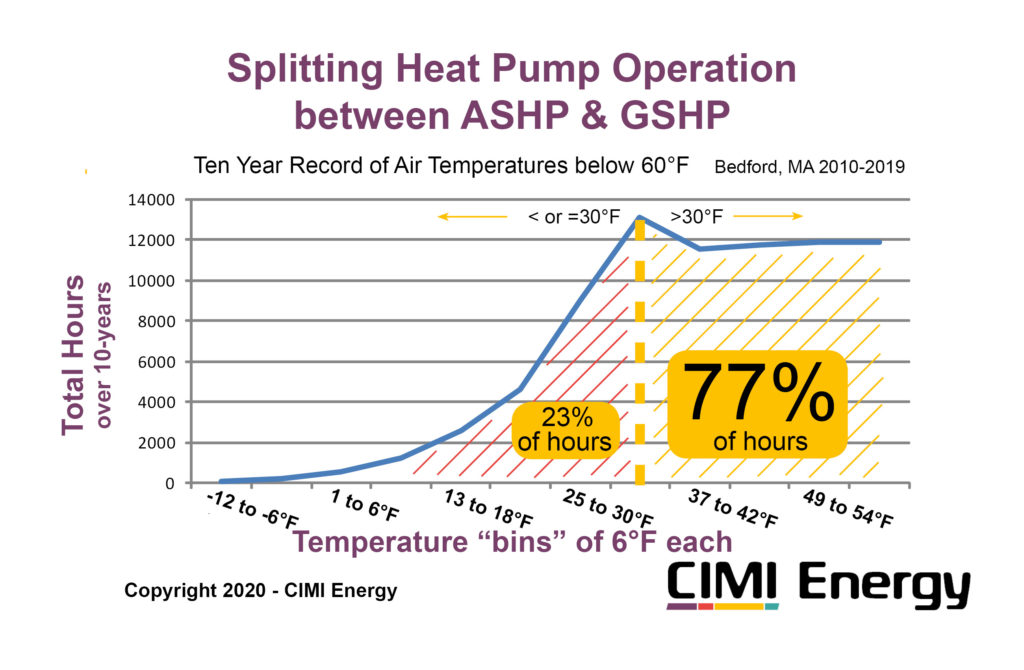
Making energy systems proactive is a logical step forward in improving building energy efficiency
Proactive building energy systems can increase energy efficiency, improve comfort, lower energy costs, reduce peak energy loads, and increase property values.
What is a proactive building energy system?
A proactive building energy system uses forward-looking input factors such as a building’s thermal momentum, near-term weather forecasts*, and demand costs to help determine system outputs. Artificial intelligence (AI) software uses strings of data inputs and self-learning to calculate outputs and optimize system performance.
A proactive energy system can be an add-on part of a very basic system, or it can can be integrated with a complex building management system (BMS) using open protocols or something else.
Contrast with today’s reactive energy systems
Nearly all building energy systems in North America today are reactive. A typical example would be a temperature set-point being reached which triggers a relay that starts or stops one or more devices (e.g. pump, boiler, chiller). There may be a variable component to the output, such as a distribution temperature selected from a heating curve. Commonly, a PID control determines the targeted output . The production and distribution technologies themselves (e.g. condensing boilers, variable speed heat pumps, low-temp hydronic distribution, etc.) may be high efficiency in a stand-alone sense. Nevertheless, they are limited by the narrow range of input data that are available to them.
Key differences between reactive and proactive system control
When external factors are changing quickly as is typical with nearly constant changes in weather factors (such as temperature), or when demand rates kick in, the reactive system loses its ability to optimize energy inputs.
Proactive energy systems on the other hand, use a range of data that includes forward-looking data that feed dynamic algorithms. With proactive systems, there can also be some automated learning involved as improvements build on past improvements. This is where AI can play an important role. The AI is used to determine thermal inertia and thermal momentum, both of which are important for maintaining targets without over or under performance. Reactive controls don’t have this ability.
Fortunately, there are more similarities than differences. Proactive systems and reactive systems use the same building assets. So from an upgrade perspective, it can be very easy to make the change.
Examples of proactivity in our lives
Although you may not have thought about it in this way, being proactive is a natural part of our everyday lives. There are countless examples of being proactive that illustrate this point.
Here are a just a few examples from one thing many of us do every day: drive a car. Imagine you’re behind the wheel of your car and you’re driving down the  road. You see a sign that says “Stop Ahead”. This is an opportunity to be proactive. You can take your foot off the accelerator and let the momentum of the car carry you forward to the stop line. That’s proactive and saves a little bit of energy. Now imagine you’re on a highway and you see a sign that says “Exit Right 1 Mile”. If that’s your exit, you can look for a good opportunity to move over to the right lane. That’s also being proactive. A third example is when you drive with your high beams on at night, you’re gaining more “visual data”; you can be more proactive in dealing with upcoming road hazards.
road. You see a sign that says “Stop Ahead”. This is an opportunity to be proactive. You can take your foot off the accelerator and let the momentum of the car carry you forward to the stop line. That’s proactive and saves a little bit of energy. Now imagine you’re on a highway and you see a sign that says “Exit Right 1 Mile”. If that’s your exit, you can look for a good opportunity to move over to the right lane. That’s also being proactive. A third example is when you drive with your high beams on at night, you’re gaining more “visual data”; you can be more proactive in dealing with upcoming road hazards.
Of course, being proactive doesn’t necessarily have to lead to greater efficiency. Proactive measures in energy are worth doing if they help achieve an objective like lower energy use, lower demand charges, or higher comfort.
Thermal momentum quantified and used proactively
Being proactive helps increase efficiency in cases where momentum (including thermal momentum) and inertia are significant factors. Thermal momentum is identified and used by AI for proactive control.
As momentum is the product of mass and velocity, higher mass leads to higher momentum. As an example of this concept, heavy trucks benefit more from that “Stop Ahead” sign than does a car, and the car benefits more than a bicycle. A pedestrian may not benefit at all. So the greater the mass, the greater the momentum, and this is true in buildings as well. Proactive AI control can account for momentum and inertia, and use it to improve overall efficiency.
A multifamily building is full of walls, floors, ceilings, carpeting, furniture, and plumbing. Therefore it is relatively dense. An empty airplane hangar, a big space filled with nothing but air, is not dense. As a result, changes in thermal energy can occur much more quickly in the hangar (assuming the building size, energy systems, and building envelopes are equivalent). Because the multifamily building is denser, it takes longer to heat up, and is slower to cool down. All that mass inside the building is a heat sink. That mass is absorbing and radiating back out thermal energy constantly. If a heating system reacts to a set point being reached, and stops pumping heat into the building, that building mass will continue to radiate heat back into the living space. If the outdoor temperature rises or sunlight streams in, the interior of the building can become overheated.
Consistent building temperatures with proactive control
Another thing we can say about the multifamily building is that steady temperature is important to the people that live there. Zeroing in on a set point temperature is a challenge that is easier with AI and proactive control. Multifamily building owners know that the alternative to consistent indoor temperatures is either complaints, open windows in winter, or both. It also can lead to higher energy costs, increased tenant turnover, and lower rents.
Lowering demand peaks in district energy with proactive control
In cases where there is an energy demand rate**, it’s possible for a proactive energy system to optimize operation to pre-load heating or cooling, and to hold back from the high demand peaks that drive demand charges. As noted earlier, this is a valuable tool where building mass can be used to advantage. This is most common for buildings connected to district energy networks, but is evident in other energy scenarios as well.
Other applications for proactive energy control
Besides thermal energy, as described above, there are other forms of energy consumption that can, and sometimes do benefit from proactive control.
- Natural gas consumption
- Electrical power (demand response)
- District energy (heating or cooling)
- Chilled water /sensible cooling
Back to top of post
*useful weather data may include the timing of upcoming temperature, sunlight, wind, and precipitation.
**energy demand rate – charged by some district energy utilities and electric utilities. Demand charges may be tiered, and can vary by time of day and time of year. In some cases demand rates change daily, with a day or less of advance notice. Demand charges help utilities pay for the higher marginal cost of supplemental energy sources, or the cost of infrastructure needed to meet peak demand.
© 2019
The Point of Being Proactive
Proactive means forward-looking. Humans are naturally forward looking. We plan ahead; make budgets, plan our days, plan our vacations, plan for retirement, and so on. We do this because we know that the alternative to being proactive, which is being reactive, leads to less desirable outcomes (e.g. “Oh, today is my vacation, I think I’ll go to the airport and fly somewhere warm!”). 
Most of us learn this by the time we are in high school. We’re able to be proactive because we’re capable of thinking ahead, and there’s usually some data we can use to help us plan ahead. We look at movie schedules, flyers for school plays, announcements of sports events and the like. All that foreknowledge is “data” that we can use to plan our lives.
We also use weather forecasts for some personal energy-related planning.
- We bring along a hat and coat if we’re anticipating wintry weather.
- We close our windows if we’re expecting rain or cold.
- We close the window shades if we’re expecting a lot of sunlight on a summer day
So the point here is that being proactive is natural, depends on data, and usually leads to more desirable outcomes than is the usually the case for the alternative.
Please read the post titled “Time to Make Energy Systems Proactive” for a closer look.
Yesterday’s state-of-the-art steam heating systems will benefit from an upgrade to the innovative heating technology developed by Leanheat. This technology lowers energy use and costs. It does this by getting steam heating systems to run more efficiently.
Unlike hydronic systems which can easily regulate supply temperatures, steam systems always boil water to make steam. Making steam from hot water requires what’s known as a phase change (liquid to gas). Boiling water through this phase change requires a lot of extra energy*, so to wasting the energy, it’s important to limit the amount of steam produced to as close to what’s necessary to maintain comfort as possible. Steam systems are very sensitive to systemic heat loss because there’s a high temperature difference between the steam and the much lower temperatures around the system. Latent heat loss is costly, and drags down system efficiency to a much greater degree than is the case in the aforementioned hydronic systems, for example. For larger steam systems, there’s also an energy consuming vacuum pump that runs to distribute the steam. So the overall energy footprint of these systems is high.
Steam systems as they were initially constructed contained only passive energy saving technology. They relied on pipe insulation and good boiler design. But because getting even a little bit of heat through the building requires expending a lot of energy, any cycling on and off, plus overshoot effects lead to very inefficient operation.
Today’s steam systems typically operate with the first generation of active efficiency improvements. Outdoor temperature, together with a heating curve are used to limit the amount of time the boiler produces steam. For example, milder days require less heat, so by using the outdoor temperature as a factor to limit the time that steam is produced in each cycle, the costly waste of latent heat (see below) that results from overshoot (and thus overheated rooms and opening of windows) is partially avoided. The downside of this control technology, outdoor reset, is that it’s not able to account for outdoor temperature changes ahead of time, so a conservative buffer is required, which has a cost in lower efficiency.
What Leanheat technology does is take this concept of active energy saving quite a bit further, with more and better factors used to determine the amount of steam produced by the boilers. For example, rather than base the heat production of a long-lag heating system on the outdoor temperature right now, Leanheat factors in where the outdoor temperature is going (based on weather data), solar effects (e.g. expected sunshine or cloud cover), windchill effects, and so on. It also factors in how quickly room temperatures change when the boiler is running.
As a result of the Leanheat upgrade, less of a temperature buffer is required, and temperatures are more consistently comfortable throughout the building. The system also runs more efficiently, lowering costs.
More Reading
Read more about this topic in the blog post on outdoor reset here, and in the context of a building’s Unique Energy Fingerprint here.
And how lower energy costs effect property values here.
*It takes about 8,000 BTUs of energy to turn a gallon of boiling water into steam. An 80% efficient steam boiler would require over 10,000 BTU to make steam from a gallon of boiling water. The energy in the steam, know as latent heat, is given off as it condenses in the pipes and radiators.
Back to top of post
It’s now possible to lower energy costs by applying bundled technologies that find and use each building’s “Unique Energy Fingerprint” (UEF).  Our partner Leanheat has created energy intelligence software that bundles artificial intelligence (AI) with the Internet of Things (IoT) to determine each building’s UEF. The technologies integrate seamlessly with existing building assets. Building energy use is reduced through improvements in system efficiency.
Our partner Leanheat has created energy intelligence software that bundles artificial intelligence (AI) with the Internet of Things (IoT) to determine each building’s UEF. The technologies integrate seamlessly with existing building assets. Building energy use is reduced through improvements in system efficiency.
Before this technology became available, this level of efficiency improvement was not achievable in a cost-effective way using current assets. Improvements that have been made have been limited by the available technology. The potential for improved control technology has expanded greatly. Leanheat has been able to focus on realizing that potential for the purpose of lowering building energy use and costs.
There are two major differences between using a building’s UEF and today’s common control optimizer, outdoor reset (OR). First is that the UEF is based on more variables (as opposed to just one or two with OR), giving a more precise picture of the heating and cooling load at any given time. Second, the technology that determines the UEF is able to anticipate loads, and thus to proactively optimize settings so that energy use is reduced.
Proactive beats reactive.
Outdoor reset is reactive. It operates on a curve tied to the outdoor temperature. Outdoor reset depends on finding a heating curve that matches up with the output with the load. Because outdoor reset is reactive, there’s an inherent uncertainty with the load matching. To compensate, outdoor reset curves must provide some extra buffer, and that extra buffer creates inefficiency.
On the other hand, Leanheat proactively anticipates the heating and cooling needs of the building. It does this in two ways. First, it factors in more data related to weather and climate. Factors include:
1. Present and anticipated outdoor temperatures
2. Present and anticipated solar irradiation (sunshine) on the building
3. Sun angle (latitude, time-of-day, and time-of year)
4. Wind direction and speed (“building wind chill”)
Other factors are indirectly (and automatically) factored in based on how the building responds:
1. Capacity of the heating and cooling system assets
2. Building mass & orientation
3. Insulation, windows, etc.
4. Air infiltration
Together, these are the variables that make a building’s UEF. Because it uses more variables, it’s able to get a more complete picture of the building’s energy load.
The second way that the Leanheat technology is proactive is that it monitors how building data correlates with naturally occurring changes in weather. As a result, the technology finds the UEF and its algorithms keep the building systems matched appropriately to current and incoming weather. The result is a typical cost savings of 10-15%.
Proactive heating and cooling control is especially important in buildings that react slowly to changes in weather and climate factors. Of course, any building with traditional controls can react slowly to a cold front with wind and rain or snow. Or when the cloud cover breaks up and suddenly the building is in full sunshine. Proactive technology controls the water temperature (or steam) with greater precision (and “less cushion”) than is possible with a reactive-based system like outdoor reset.
Back to top of post






 road. You see a sign that says “Stop Ahead”. This is an opportunity to be proactive. You can take your foot off the accelerator and let the momentum of the car carry you forward to the stop line. That’s proactive and saves a little bit of energy. Now imagine you’re on a highway and you see a sign that says “Exit Right 1 Mile”. If that’s your exit, you can look for a good opportunity to move over to the right lane. That’s also being proactive. A third example is when you drive with your high beams on at night, you’re gaining more “visual data”; you can be more proactive in dealing with upcoming road hazards.
road. You see a sign that says “Stop Ahead”. This is an opportunity to be proactive. You can take your foot off the accelerator and let the momentum of the car carry you forward to the stop line. That’s proactive and saves a little bit of energy. Now imagine you’re on a highway and you see a sign that says “Exit Right 1 Mile”. If that’s your exit, you can look for a good opportunity to move over to the right lane. That’s also being proactive. A third example is when you drive with your high beams on at night, you’re gaining more “visual data”; you can be more proactive in dealing with upcoming road hazards. 
 Our partner Leanheat has created energy intelligence software that bundles artificial intelligence (AI) with the Internet of Things (IoT) to determine each building’s UEF. The technologies integrate seamlessly with existing building assets. Building energy use is reduced through improvements in system efficiency.
Our partner Leanheat has created energy intelligence software that bundles artificial intelligence (AI) with the Internet of Things (IoT) to determine each building’s UEF. The technologies integrate seamlessly with existing building assets. Building energy use is reduced through improvements in system efficiency.